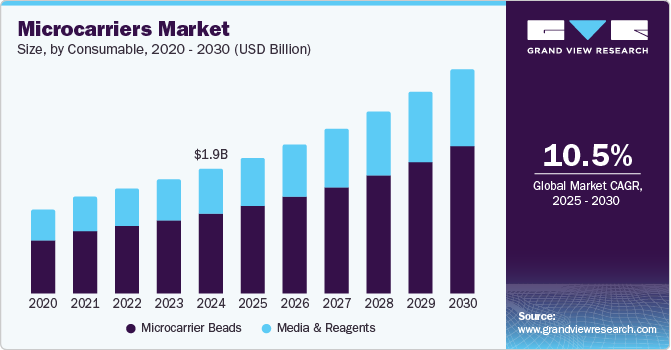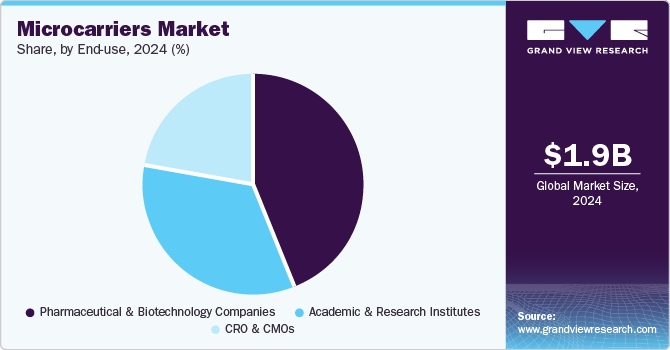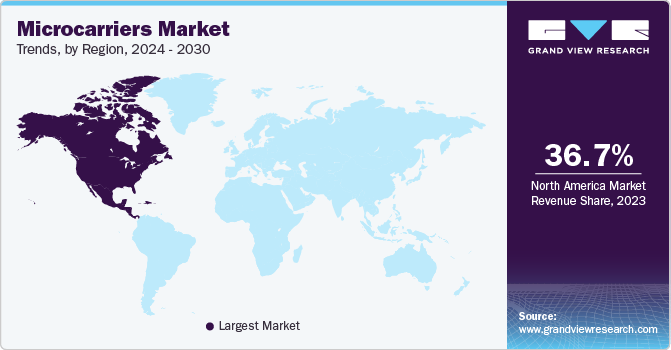
Microcarriers Market Size, Share & Trends Analysis Report By Consumable (Media & Reagents, Microcarrier Beads), By Application (Biopharmaceutical Production, Regenerative Medicine), By End-use, By Region, And Segment Forecasts, 2025 - 2030
- Report ID: GVR-4-68039-991-5
- Number of Report Pages: 120
- Format: PDF, Horizon Databook
- Historical Range: 2018 - 2024
- Forecast Period: 2025 - 2030
- Industry: Healthcare
Microcarriers Market Size & Trends
The global microcarriers market size was estimated at USD 1.95 billion in 2024 and is expected to grow at a CAGR of 10.49% from 2025 to 2030. The growth of microcarriers market is attributed due to the high demand of cell-based vaccines & therapeutics, increasing incidence of various diseases & disorders such as diabetes, cancer, rheumatoid arthritis, hemophilia and others, huge investments for development of innovative therapies and consistent technological advancements in cell biology research. For instance, in May 2024, Sartorius and Sanofi partnered to develop and commercialize a platform that streamlines and optimizes downstream bioprocessing operations, enhancing efficiency and productivity in the production of biopharmaceuticals. This can lead to the development of more sophisticated microcarrier-based bioprocessing technologies.

High demand for cell-based vaccines and therapeutics is a significant driver of the microcarriers market. Cell-based vaccines and therapeutics are becoming increasingly popular due to their potential to provide more effective and targeted treatments for various diseases such as cancer, infectious disease and many others. Microcarriers play a crucial role in producing cell-based products by providing a platform for cell culture expansion. The use of microcarriers allows for efficient growth and cell maintenance, which is further essential for large-scale production of vaccines and therapeutics.
As the global population grows and ages, there is a higher prevalence of chronic and infectious diseases such as cancer, cardiovascular diseases, and autoimmune disorders. This increased burden of diseases has led to a growing demand for novel treatments, including cell-based therapies that utilize microcarriers for cell culture expansion.
Substantial investments in the development of innovative therapies are driving the microcarrier market growth. Pharmaceutical companies, biotechnology firms, and research institutions invest heavily in advancing cell-based therapies to address unmet medical needs. These investments support R&D efforts to leverage microcarriers to scale up the production of cell-based vaccines, gene therapies, regenerative medicine products, and other advanced therapeutics. For instance, Eppendorf has invested in developing microcarrier-based cell culture systems, aiming to improve efficiency and scalability.
The consistent technological advancement in cell biology research is also fueling the expansion of this market. Advances in cell culture techniques, bioreactor systems, imaging technologies, and biomaterials have enhanced our understanding of cellular behavior and function. These advancements have enabled researchers to optimize cell culture processes using microcarriers, improving efficiency, scalability, and reproducibility in manufacturing cell-based products.
Consumable Insights
Microcarrier beads was identified as the larger contributor with 64.46% share in 2024. The ever-expanding use of microcarrier beads during cell culture contributes to the highest revenue generation in the market. Increased cell biology research, growing demand for regenerative medicines & biopharmaceuticals, and the presence of various microcarrier beads that can be employed for different purposes attributed to the significant market growth.
Vast product offerings by key market players and continuous developments in microcarrier technology have recreated lucrative opportunities and resulted in the launch of novel products. Companies such as Sartorius AG offer microcarrier beads that are animal component-free and animal protein coated for adherent cell culturing. Thus, microcarrier beads can be extensively used during numerous processes and for research, further increasing the segment's revenue generation.
Application Insights
The biopharmaceutical production segment captured the largest market share 71.81%, in 2024, due to the growing cases of infectious diseases & genetic disorders and increasing cancer incidence, resulting in increasing demand for producing safe & effective medicines or treatments. Biopharmaceutical companies are expanding their capacities and product offerings to meet the growing demand. For instance, in August 2022, Celltrion Inc., a Korea-based healthcare company, announced the approval of the European Commission for its Bevacizumab biosimilar, Vegzelma, for treatment of some types of cancer such as glioblastoma, colorectal cancer and others. With this 3rd biosimilar approval, the company has expanded its oncology care portfolio for use in Europe
The regenerative medicine segment is anticipated to grow significantly over the forecast period. This segment is driven by the increasing prevalence of chronic diseases, advancements in stem cell research, and the growing demand for personalized healthcare solutions. In the microcarrier market, the application insights focus on developing innovative drug delivery systems that utilize regenerative medicine principles to enhance targeted therapy and tissue regeneration. For instance, in March 2023, Hyperion Drug Discovery Co., Ltd. (HDD) and Dai Nippon Printing Co., Ltd. (DNP) collaborated in Tokyo to create soluble microcarriers for scaffolds in cell culture processes. These carriers have applications in regenerative medicine, gene therapy, exosomes, biopharmaceuticals, and cultured meat.
End-use Insights
The pharmaceutical & biotechnology companies segment captured the largest market share at 43.95% in 2024 and is anticipated to grow significantly over the forecast period. The microcarriers market is driven by several key factors for pharmaceutical and biotechnology companies, primarily due to the growing demand for scalable and efficient production of biologics, including monoclonal antibodies, cell-based vaccines, and gene therapies. As these companies increasingly invest in cell culture systems for large-scale biomanufacturing, microcarriers become essential for expanding adherent cells, offering a cost-effective solution that supports high-density cultures in bioreactors. The advancements in regenerative medicine and stem cell research have also spurred the adoption of microcarriers, enabling pharmaceutical and biotech firms to produce therapeutic cells for treatments such as cell therapies. In addition, the focus on process optimization and automation in bioprocessing has driven the demand for microcarrier technologies that facilitate consistent production yields, further supporting the development and commercialization of next-generation biologics and personalized medicines.

The academic & research institutes segment is anticipated to grow significantly over the forecast period due to the need for advanced tools to conduct experiments, analyze data, and develop innovative solutions. These institutions require microcarriage for various applications such as microscopy, cell manipulation, drug delivery systems, and nanotechnology research. The demand for high-precision equipment with enhanced capabilities fuels the adoption of microcarriage in academic and research settings.
Regional Insights
North America generated the highest revenue with a 41.11% share in 2024. The area is witnessing a surge in chronic and infectious diseases, necessitating advanced medical treatments. This increasing health concern has led to an increasing demand for personalized medicines that cater to individual patient needs. For instance, the U.S. FDA predicts that by 2025, it would start approving around 10 to 20 cell & gene therapy products annually due to the current clinical success rates and the product pipeline. Also, as per a fact sheet in November 2021, the U.S. FDA stated that about 621 biologics products are licensed. Continuous product approvals and the bio-manufacturing market's growth drive the microcarriers market's presence in North America.

U.S. Microcarrier Market Trends
The microcarrier market in the U.S. held the largest share in North American region in 2024 and is expected to grow rapidly over the forecast period. The driving factors behind this growth include the increased utilization of microcarriers for cell-based vaccine manufacturing, advancements in technology that support cell production using microcarriers, higher investments in cell and gene therapy research, a preference for single-use technologies, and a rise in R&D expenditure for biopharmaceutical production. For instance, in August 2023, Astellas Pharma Inc. and Poseida Therapeutics, Inc. announced a strategic partnership. This aims to support Poseida’s efforts in advancing cancer cell therapy, reflecting the increasing demand for microcarriers in the US due to the growing number of chronic disease cases and the approval of various cell and gene therapies.
Europe Microcarrier Market Trends
The European microcarriers market presents significant growth opportunities with the increasing adoption of advanced technologies in cell culture processes. The rising demand for biopharmaceuticals, gene therapies, and regenerative medicine drives the need for efficient cell culture solutions. Additionally, the emergence of 3D cell culture techniques and the growing demand for monoclonal antibodies and biosimilar offer prospects for market expansion.
Substantial investments in cell and gene therapy studies, rising adoption of microcarriers in cell-based vaccine manufacturing, progressions in technology for producing cells using microcarriers, increased R&D expenditures in biopharmaceutical manufacturing, and a favoring of disposable technologies are shaping the UK microcarriers market. Opportunities arise from rising demand for 3D cell culture, increasing demand for monoclonal antibodies (mAbs) and biosimilar, and the high-growth potential of emerging economies within the UK’s sphere of influence.
Germany is known for its intense R&D capabilities, especially in areas related to biopharmaceuticals and cell culture technologies. The increasing R&D activities and technological innovations in Germany contribute to the microcarrier market’s growth. The adoption of single-use technologies, a significant trend driving the global microcarrier market, is also observed in Germany. The shift towards single-use technologies in cell culture, including using consumables such as media and reagents, promotes growth within the microcarrier industry.
Asia Pacific Microcarrier Market Trends
Asia Pacific region is primarily influenced by the increasing demand for biologics within its domestic market and the growth of its economies, alongside having the highest population of seniors. Moreover, numerous local Asian and international companies are establishing various cutting-edge bioprocessing facilities in this area. For example, in March 2024, MilliporeSigma has announced a significant €300 million investment in establishing a new bioprocessing facility in South Korea. This state-of-the-art facility will cater to the growing demand for biologics within the Asia Pacific region, providing comprehensive support to biotech and pharmaceutical companies.
The microcarrier market in Japan is experiencing significant growth driven by several key factors. The increasing demand for cell-based therapies has been a major catalyst for the market expansion. Cell culture techniques are crucial in producing cell therapies, leading to a surge in the need for microcarriers that provide a three-dimensional environment for cell growth. The focus on personalized medicine and the development of innovative cell-based therapies are expected to further drive the microcarrier market in Japan during the forecast period.
The microcarrier market in China has witnessed significant growth and is expected to continue the upward trajectory. Market dynamics in China for microcarriers are influenced by various increasing investments in cell and gene therapy research, technological advancements supporting microcarrier-based cell production, and the growing demand for biopharmaceutical production. For instance, in July 2023, cell and gene therapy production in China is scaled up by leveraging 3D manufacturing platforms and microcarrier technology to enhance efficiency and scalability.
Latin America Microcarrier Market Trends
The Latin American microcarrier market is strengthened by increasing demand for biopharmaceuticals and cell therapies, driven by a growing healthcare sector and rising prevalence of chronic diseases. Microcarrier technology advancements, increasing R&D activities, and government support further fuel market growth. Additionally, the preference for single-use technologies enhances the adoption of microcarriers in bioprocessing applications across the region.
The trends in the Brazilian microcarrier market align with broader global trends but could also be influenced by specific factors relevant to the Brazilian biopharmaceutical and research landscape. These trends include adoption rates of microcarriers for cell production, preference for single-use technologies, substantial investments in cell and gene therapy research.
MEA Microcarrier Market Trends
The MEA microcarrier market is propelled by a burgeoning biopharmaceutical industry and escalating demand for cell and gene therapies across the region. Microcarrier technology advancements, along with increasing research and development activities and government initiatives, contribute to market expansion.
The UAE microcarrier market is growing due to the expansion of the biopharmaceutical and healthcare sectors, which are driven by increasing investments and government initiatives. Rising demand for cell-based therapies and vaccines and advancements in microcarrier technology are further propelling market expansion.
Key Microcarrier Company Insights
The microcarriers market is growing due to continuous technological developments and the upswing in technologies employed during cell biology research. The prevalence of diseases and the need for treatment have created numerous opportunities in the cell therapy industry. These market opportunities have allowed emerging players to enter, who make a breakthrough with innovation and advanced new products. For instance, Thermo Fisher Scientific introduced a new technology for cell therapy manufacturing in September 2023. This technology, called Gibco CTS Detachable Dynabeads, provides a novel way to release cells during manufacturing. The system is designed for use in both commercial and clinical settings, offering a flexible and efficient solution for cell therapy production. Launching new products, new market entrants, and the presence of existing & matured key players intensifies market competition and boosts the microcarrier’s market growth.
Key Microcarriers Companies:
The following are the leading companies in the microcarriers market. These companies collectively hold the largest market share and dictate industry trends.
- Thermo Fisher Scientific, Inc.
- Merck KGaA
- Danaher Corporation
- Sartorius AG
- Corning Incorporated
- Eppendorf SE
- Bio-Rad Laboratories, Inc.
- HiMedia Laboratories Pvt. Ltd.
- denovoMATRIX GmbH
Recent Developments
-
In October 2023, Kuraray Co., Ltd., headquartered in Chiyoda-ku, Tokyo, under the leadership of President Hitoshi Kawahara, developed PVA hydrogel microcarriers for cellular cultures in regenerative medicine. These pioneering items are slated for launch in January 2024, initially in Japan, with plans for subsequent expansion into the United States and other global markets.
-
In October 2023, Semarion, a biotechnology company specializing in innovative solutions for cell culture applications, unveiled its Early Adopter Programme for the SemaCyte Microcarrier Platform. This program was designed to introduce and promote the adoption of their new microcarrier platform among early adopters in the scientific and research community.
-
In June 2023, Teijin Frontier Co., Ltd., a company within the Teijin Group specializing in fibers and product conversion, introduced novel nonwoven microcarriers designed to enhance rapid, large-scale, and high-quality cell culture. These microcarriers serve as supportive structures for various cell types, promoting attachment and growth in three dimensions.
Microcarriers Market Report Scope
|
Report Attribute |
Details |
|
Market size value in 2025 |
USD 2.13 billion |
|
Revenue forecast in 2030 |
USD 3.50 billion |
|
Growth rate |
CAGR of 10.49% from 2025 to 2030 |
|
Actual data |
2018 - 2024 |
|
Forecast period |
2025 - 2030 |
|
Quantitative units |
Revenue in USD million/billion, CAGR from 2025 to 2030 |
|
Report coverage |
Revenue forecast, company ranking, competitive landscape, growth factors, and trends |
|
Segments covered |
Consumable, application, end-use, region |
|
Regional scope |
North America; Europe; Asia Pacific; Latin America; MEA |
|
Country scope |
U.S.; Canada; Mexico; UK; Germany; France; Italy; Spain; Denmark; Sweden; Norway; Japan; China; India; Australia; South Korea; Thailand; Brazil; Argentina; South Africa; Saudi Arabia; UAE; Kuwait |
|
Key companies profiled |
Thermo Fisher Scientific, Inc.; Sartorius AG, Merck KGaA; Danaher Corporation; HiMedia Laboratories Pvt. Ltd.; Eppendorf SE; Corning Incorporated; Bio-Rad Laboratories, Inc.; denovoMATRIX GmbH |
|
Customization scope |
Free report customization (equivalent up to 8 analyst’s working days) with purchase. Addition or alteration to country, regional & segment scope. |
Global Microcarriers Market Report Segmentation
This report forecasts revenue growth and provides an analysis on the latest trends in each of the sub-segments from 2018 to 2030. For the purpose of this report, Grand View Research has segmented the microcarriers market on the basis of consumable, application, end-use and region.

-
Consumable Outlook (Revenue, USD Million, 2018 - 2030)
-
Media & Reagents
-
Microcarrier Beads
-
Collagen Coated Beads
-
Cationic Beads
-
Protein Coated Beads
-
Untreated Beads
-
Others
-
-
-
Application Outlook (Revenue, USD Million, 2018 - 2030)
-
Biopharmaceutical Production
-
Vaccine Production
-
Therapeutic Production
-
-
Regenerative Medicine
-
-
End-use Outlook (Revenue, USD Million, 2018 - 2030)
-
Pharmaceutical & Biotechnology Companies
-
Contract Research Organizations & Contract Manufacturing Organizations
-
Academic & Research Institutes
-
-
Regional Outlook (Revenue, USD Million, 2018- 2030)
-
North America
-
U.S.
-
Canada
-
Mexico
-
-
Europe
-
UK
-
Germany
-
France
-
Italy
-
Spain
-
Denmark
-
Sweden
-
Norway
-
-
Asia Pacific
-
Japan
-
China
-
India
-
Australia
-
South Korea
-
Thailand
-
-
Latin America
-
Brazil
-
Argentina
-
-
Middle East and Africa (MEA)
-
South Africa
-
Saudi Arabia
-
UAE
-
Kuwait
-
-
Frequently Asked Questions About This Report
b. The global microcarriers market size was estimated at USD 1.95 billion in 2024 and is expected to reach USD 2.13 billion in 2025.
b. The global microcarriers market is expected to grow at a compound annual growth rate of 10.49% from 2025 to 2030 to reach USD 3.50 billion by 2030.
b. Microcarrier beads segment dominated the microcarriers market with a share of 64.46% in 2024.
b. Some of the key players in the microcarriers market include Thermo Fisher Scientific, Inc., Merck KGaA, Danaher Corporation, Sartorius AG, Corning Incorporated, Eppendorf SE, Bio-Rad Laboratories, Inc., HiMedia Laboratories Pvt. Ltd., and denovoMATRIX GmbH.
b. Key factors that are driving the microcarriers market are growing demand of cell based vaccines & therapeutics, and technological advancements in cell biology research.
We are committed towards customer satisfaction, and quality service.
"The quality of research they have done for us has been excellent."




